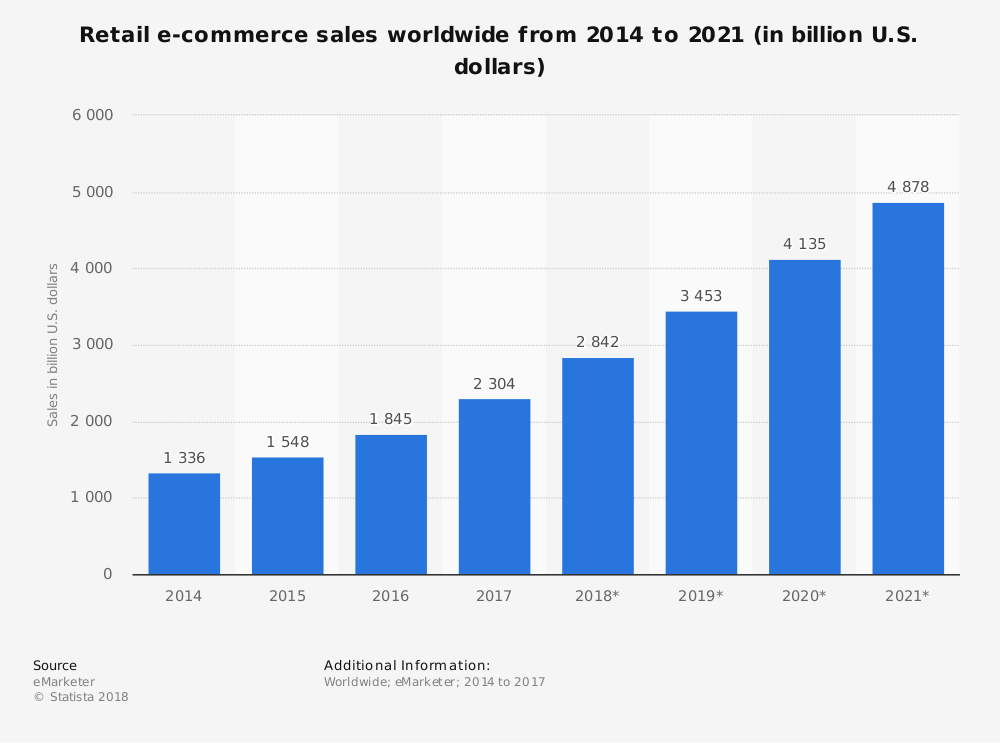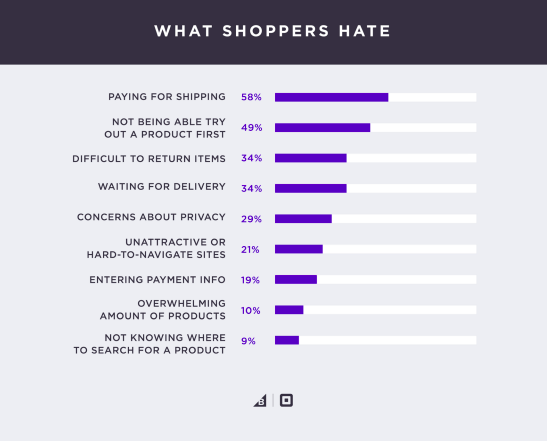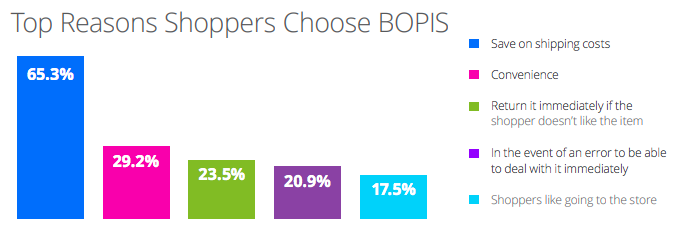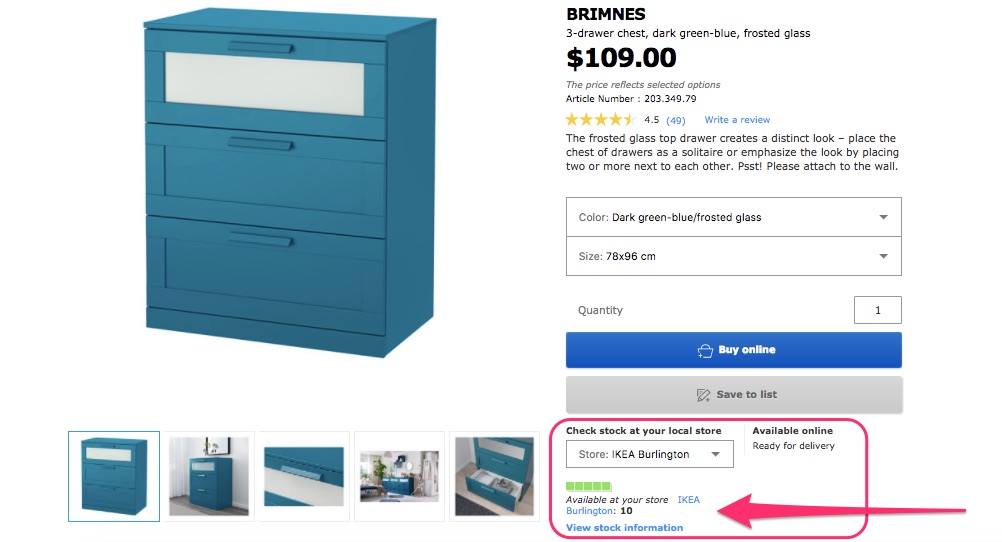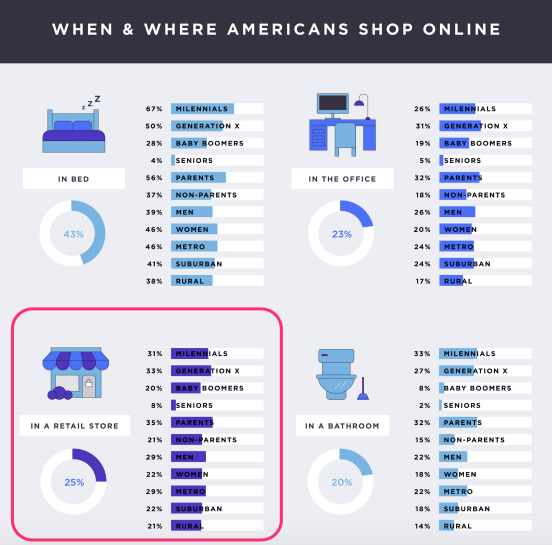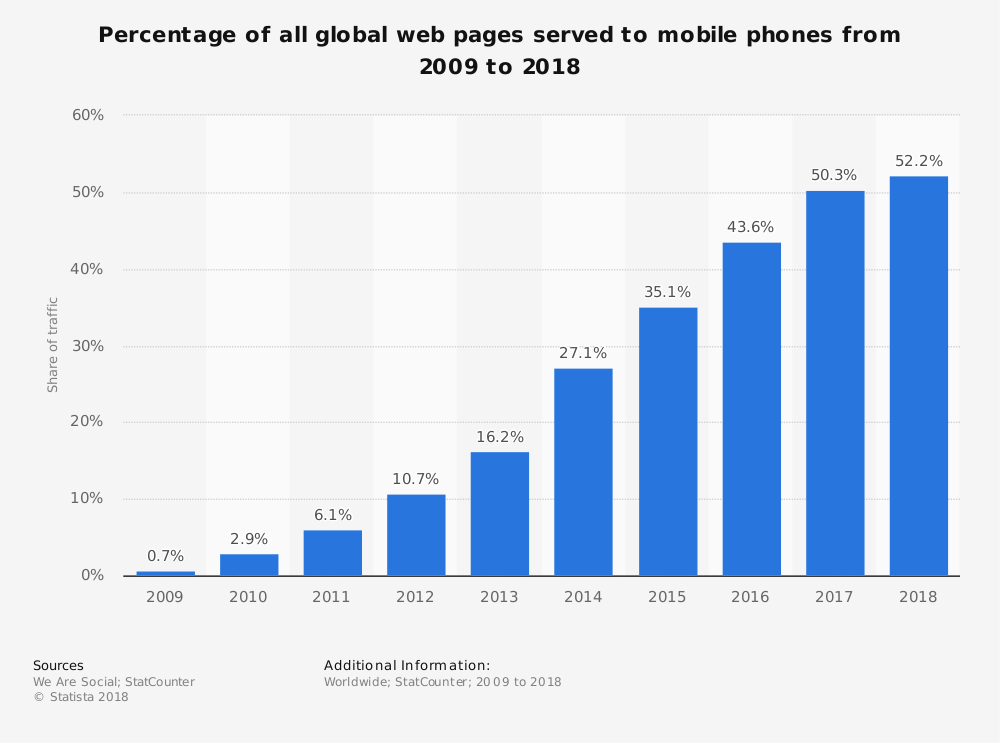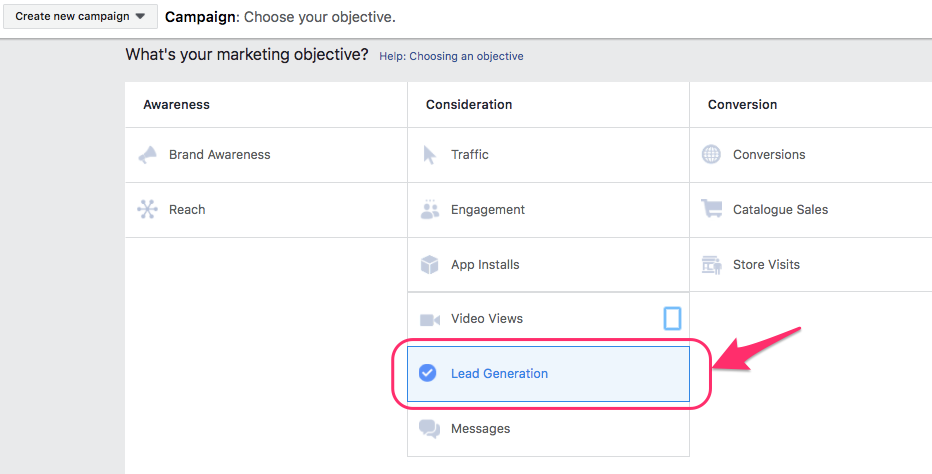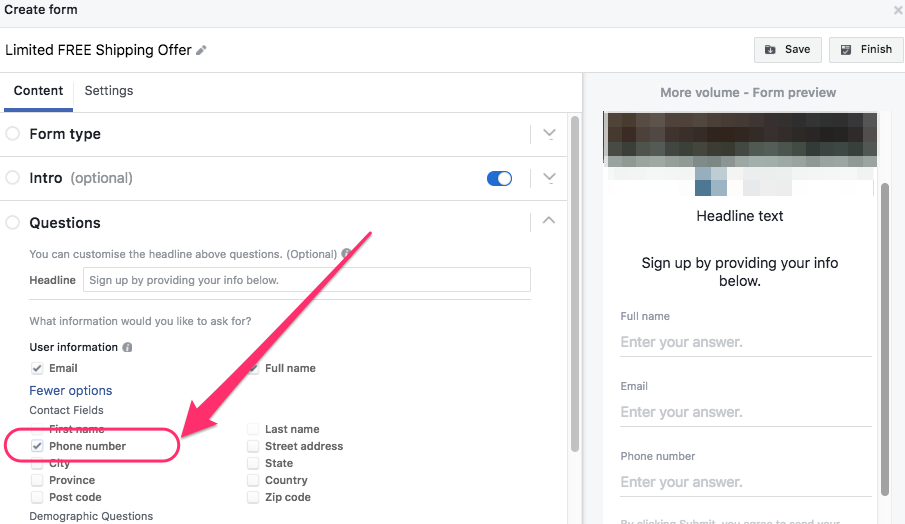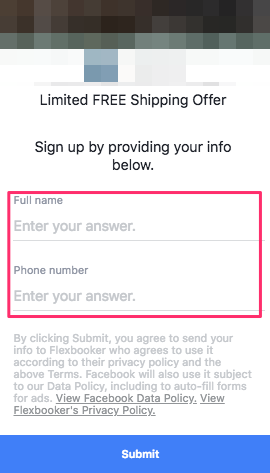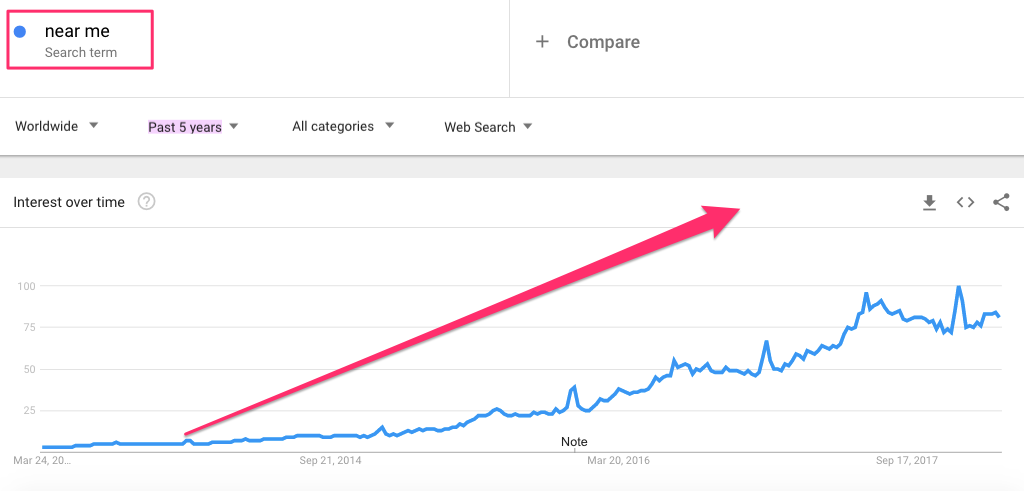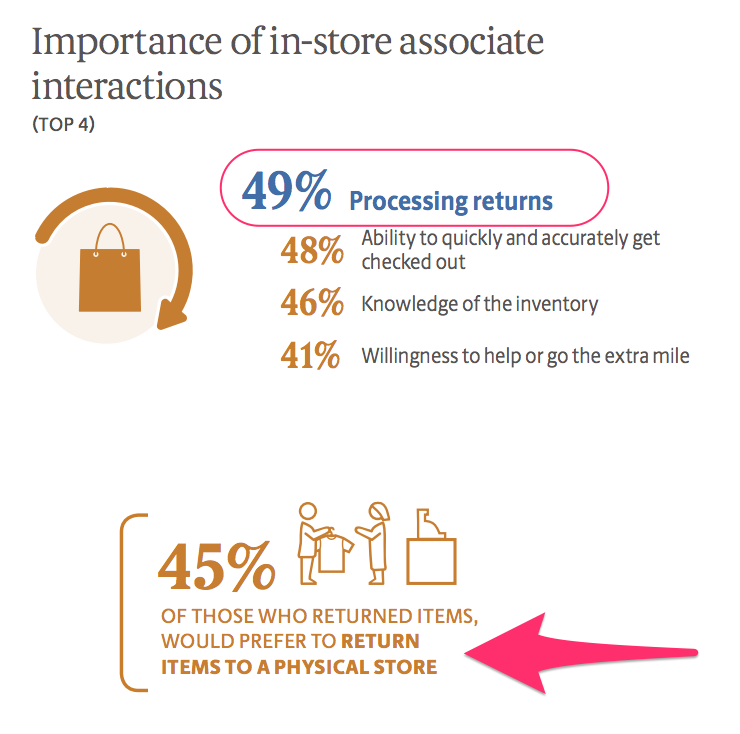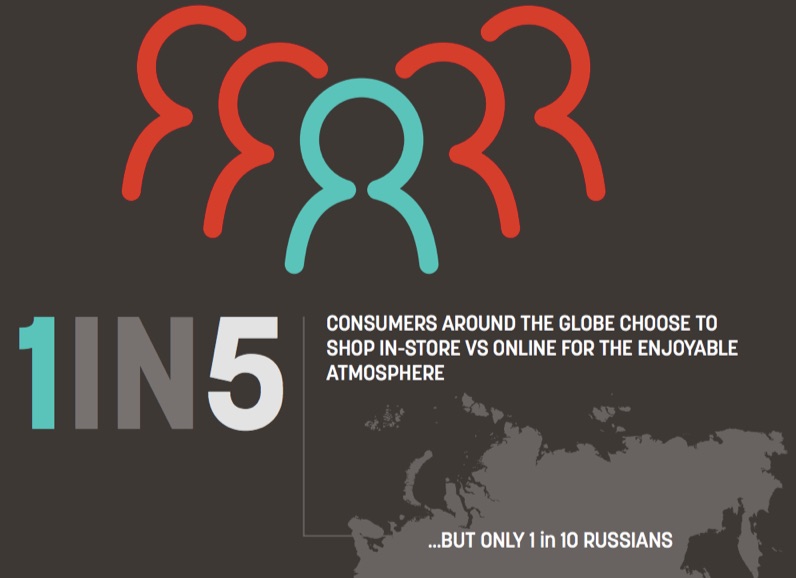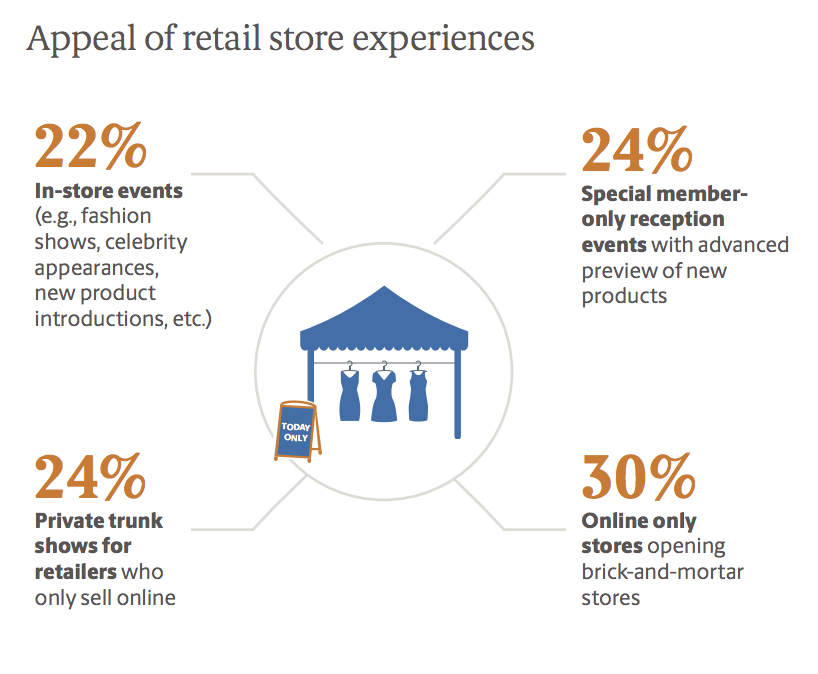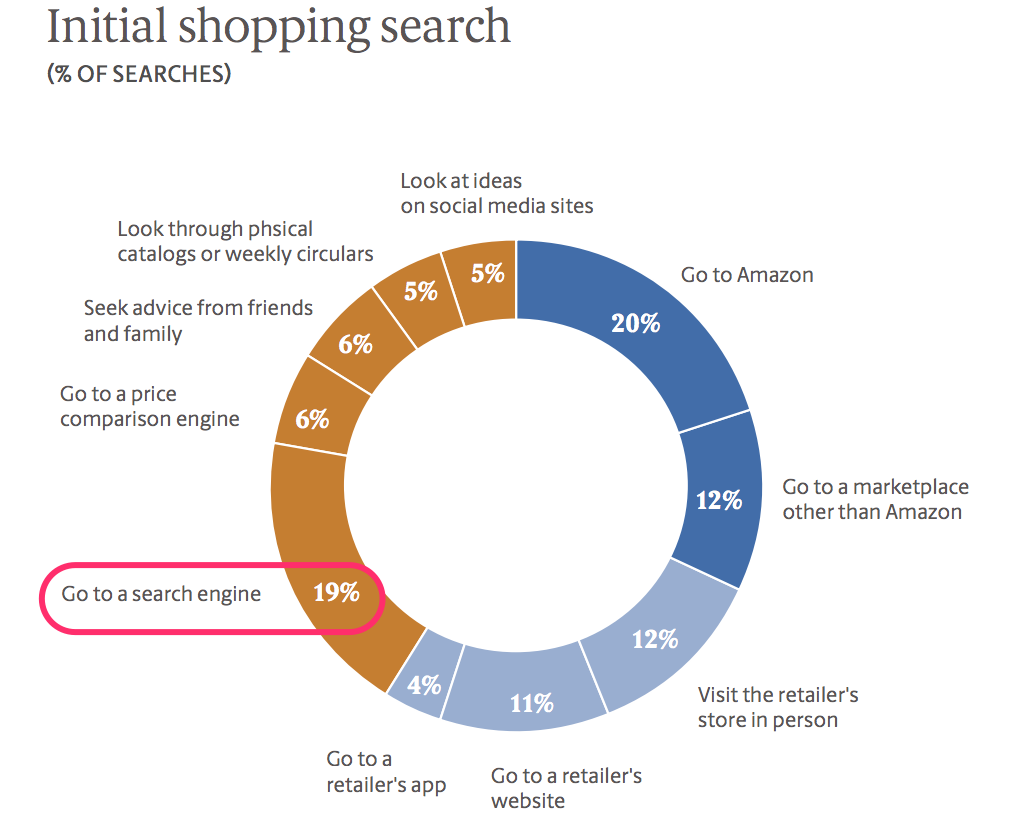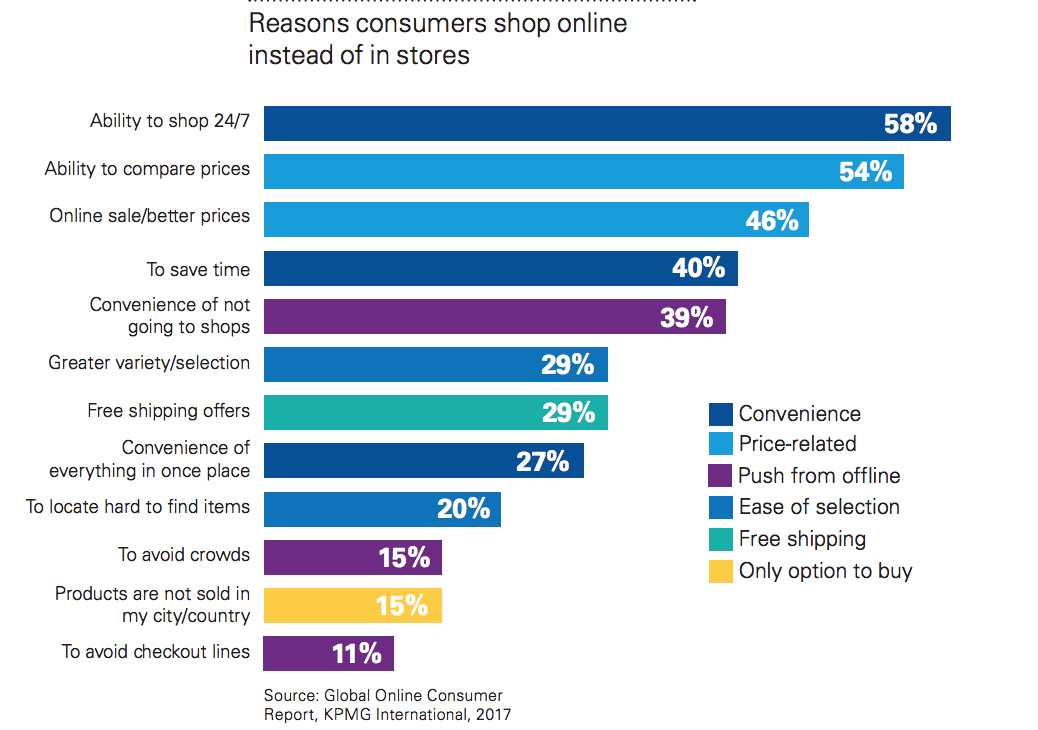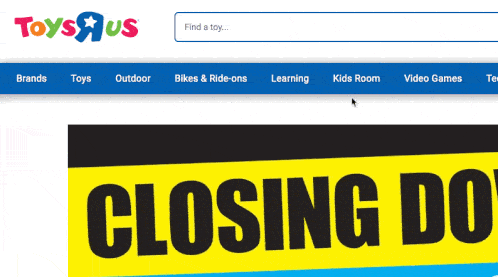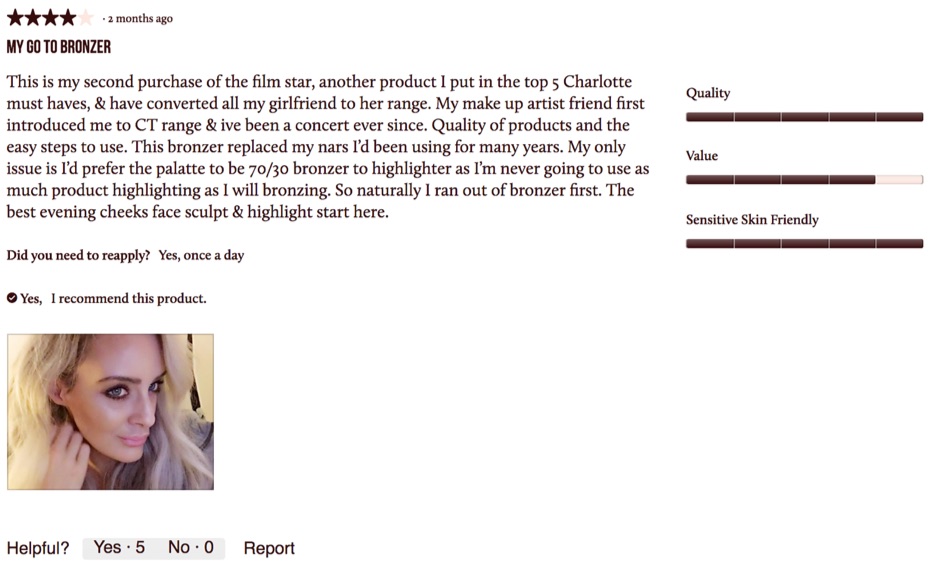Friday, 30 March 2018
9 Local E-Commerce Marketing Tips To Drive More Foot Traffic To Your Store
E-commerce is growing at a meteoric pace, and there is no doubt about it.
According to a recent study by Statista, retail e-commerce sales worldwide reached $2.4 trillion in 2017 and are expected to reach 4.9 trillion in 2021.
Interestingly, this growth pattern is not solely a retail B2C phenomenon.
In fact, B2B e-commerce worldwide sales in 2017 peaked at $7.7 trillion, which is 235% higher than B2C.
Sounds pretty impressive, right?
And these figures do tell us a lot about major changes in consumer behavior that will continue to evolve in 2018.
The shopper is more technologically advanced than ever before and is empowered to drive disruptive changes in traditional retail business.
So if consumers increasingly prefer e-commerce over brick-and-mortar shopping, why do we still need physical stores? Why do businesses still want that foot traffic?
There are a number of reasons why, but let’s just start with another very simple, yet very loud statistic.
In-store sales accounted for 91% of all retail sales in the US in 2017.
This means that brick-and-mortar is still the most popular way to shop for most Americans.
And it comes as no surprise.
The in-store shopping experience is incomparable to browsing items on a desktop or mobile screen. The ability to see, touch and try products before purchase remains the biggest motivator for consumers to shop offline.
And that’s not the only thing stopping consumers from buying online.
According to 2017 BigCommerce study, 58% of US consumers hate paying for shipping, and 34% think product return process is difficult when shopping online.
All of these are e-commerce pain points that can actually serve as huge growth opportunities for brick-and-mortar retailers.
But ultimately from a business perspective, you want to provide seamless and consistent customer experience across all sales channels and reach that omnichannel zen.
You have probably heard the term omnichannel before.
Google defines it as: “ensuring retailer marketing strategies are geared toward enabling customers to convert on any channel.”
Sounds too sophisticated.
But the main idea behind omnichannel retail marketing is to simply provide shoppers what they want, whenever and wherever they want.
That said, there are many ways you can use local e-commerce insights and marketing tactics to drive foot traffic to your store, and I will show you exactly how you can do this.
But before we dive into the realm of local e-commerce marketing tactics, you might want to check out Neil Patel’s 4 Local SEO Marketing Strategies to Build Your Brick And Mortar Business.
1. Buy online, pick up in store (BOPIS)
Since customers hate to pay for shipping, the first thing you can do to ease their pain is to offer an in-store pickup option, also known as BOPIS.
This is a very popular service offered by almost every major retailer, and it is something you can easily implement for your customers as well.
In fact, according to the Great Omnichannel Expectations 2016-2017 Shopper Survey Report by iVend, 57% of US shoppers say that they use the “buy online, pick up in store” option.
And 65.3% of those consumers say they do so to avoid delivery costs.
Another thing you can offer to drive foot traffic is the ability to reserve the product online and collect it in-store. This options works best for new product releases and can help build excitement.
Think new Apple product launches. Usually, they are sold out even before official sales date.
Although BOPIS is an attractive alternative for most shoppers, it still makes sense to provide some extra incentives, like faster shipping or even an in-store redeemable coupon.
An important thing to consider when implementing buy online pick up in store service is to make sure the whole experience is as smooth and convenient as possible.
How?
- Use a multichannel integration platform to connect your store inventory to your website and make sure they are always in sync.
- Train your in-store sales staff to serve BOPIS customers with special care and in case of immediate returns or exchanges be ready to offer more profitable alternatives.
- Put up proper in-store signage and make it extremely easy for customers to navigate the store and find the pickup location without getting overly frustrated.
2. Provide local inventory availability information
There is a common myth that consumers who search online will only visit online shops.
That is not entirely true.
In fact, three out of four consumers are more likely to visit physical stores if they find local information in search results helpful.
So why not give your consumers what they look for?
First of all, make sure your store locator is up and running. Let your shoppers easily find their local store and make sure to provide all details, like phone numbers, email, and address.
Then go one step further and provide local inventory availability information for each item and each local store.
You might be wondering why customers even need this if they can buy products online and pick up them in the store?
Well, it turns out that a lot of shoppers do not want to pay upfront, especially for specific products, like personal hygiene and care items, that are more difficult to return and get a refund for.
So informing your website visitors about the stock availability at your local store can be a great foot traffic driver for undecided customers.
Ikea is one of the biggest retailers to have successfully implemented this on their website.
It offers website visitors to choose the local store and see the inventory of a particular product in that store.
This information can be especially helpful if your customers tend to buy items in bulk.
3. Buy in store and walk out hands-free
This is a relatively new approach to retail marketing and comes as a result of shopper behavior changes as well. It serves as a good way to respond to consumer “showrooming.”
What is showrooming and why does it matter?
Showrooming has become a common way of shopping for a lot of deal hunters and simply shoppers who like to compare prices or try out products before purchasing.
Customers now can come into your store, get all information they need about the product, see and touch it, but then buy it online from another web store. How sad, isn’t it?
25% of Americans even admitted purchasing while standing in a brick-and-mortar store.
The good news is you do not need to fight this behavior. You can embrace it.
What if your customers could try products in your store and then have them delivered straight to their preferred address?
It’s an entirely new approach to retail, and a few brands have already implemented it.
For instance, Bonobos, have opened “guideshops” across the US, where you can find the perfect fit and style with the help of a professional guide.
When you’re done shopping, your orders are delivered to your home or work free of charge.
You can do this too.
4. Offer in-store redeemable mobile promotions
Did you know mobile users spend more than 4 hours a day on their phones?
Just look at this graph from Statista.
In 2017 mobile accounted for more than half of worldwide website traffic and is projected to grow even more this year.
Consumers rely more on their mobile devices to research even the smallest decisions on the go. But they also are more susceptible to mobile communication than, for instance, email.
Research shows that text message open rate in the US is 82%, which is a mind-boggling number if we compare it to email open rate, hovering at around 24%.
This once again proves that SMS marketing is not only alive but thriving. You should really consider implementing mobile marketing solutions, including phone number collection program.
If you want to speed things up a little bit, you can go for Facebook Lead Ads to collect phone numbers fast by offering something enticing in return.
Here’s how it works.
Open your Facebook Ad manager and choose your marketing objective to be “Lead Generation.”
Next, fill in all your targeting, budget, placement and scheduling details and head straight over to building the ad.
Scroll down a little bit until you see the “Create Form” section of your ad builder.
Create a new form and describe the special something your customers will receive when they sign up.
Then click the “More options” in Questions section of the form creation menu and tick “Phone number.”
It’s a good idea to have essential information fields to improve the conversion rate of your form. So keep it short and attractive.
When you’re done, your form will look something like this:
There you have it.
This will allow you to legally grow and maintain a list of your customer phone numbers to fuel your mobile marketing initiatives.
Once you have your first batch, you can start sending coupons and gift codes to your list via SMS and encourage customers to visit your brick-and-mortar store and redeem them.
Another great way to collect customer phone numbers is to incentivize them upon check out on your website, by offering free shipping or even the in-store redeemable coupon itself.
5. Optimize for near-me searches
Following the explosive growth of mobile, consumers now expect to receive specifically tailored and personalized search results whenever and wherever, using near-me queries.
So what are those near-me searches anyway?
Near-me searches are location specific search queries, usually aimed at getting quick results nearby.
This is what they look like.

Near-me searches have been growing steadily in past five years and are only taking off.
The tricky part is that it’s not enough to be geographically near the searcher to rank high in search results.
You need to really tap into local search optimization to get a piece of the “near-me pie.”
Here are some quick local SEO tips to get you started.
- Make sure your website is mobile ready, as Google will be rolling out mobile-first indexing anytime soon.
- Perfect your Google My Business listing as it is critical for local search rankings. Verify your listing and keep it up to date at all times.
- Optimize your website meta data with “near me” keywords. Do not overdo, but rather keep it relevant and user-friendly.
- Get geographic anchor backlinks from authority websites.
- Encourage customers to leave reviews on your Google My Business listing. Luckily, Google does not prohibit direct communication with customers to solicit reviews.
Shortlist your happiest customers who use Gmail and reach out to them with a quick link to review your business on Google.
6. Offer in-store exchanges and returns
Did you know that 30% of all e-commerce purchases are returned versus 8.89% of brick-and-mortar purchases?
Sounds like a lot. But it is not surprising.
Despite all technological advancements, online shoppers still do not have the opportunity to see, touch and try products before purchase.
Hence the high return rates.
There is little you can do to minimize order returns, but if you want to drive foot traffic to your store and also improve customer experience, you can offer in-store returns and exchanges.
A recent study by Invesp Conversion Rate Optimization Company, reveals that 9 out of 10 consumers will buy something again if returns are easy and hassle-free.
And 62% of shoppers are more likely to purchase online if there is an option to return items in-store.
This means that having a great in-store return and exchange experience will not only drive your customers from the web to your store, but it will also give them another reason to shop with you next time.
And this is true not only for North American shoppers but Europeans as well.
The 2017 UPS Pulse of the Online Shopper study shows that almost half of consumers would prefer to return items to a brick-and-mortar store.
And 49% of them would prefer to work with an in-store associate to process returns.
7. Organize in-store events and workshops
Having a physical store has some advantages for an e-commerce retailer, and it would be a wasted opportunity not to make use of those.
One of the best things you can do to drive foot traffic and as a result, in-store sales, is to organize various events, like new product launches, runway shows, shopping festivals, etc.
The reason why this is important and why it works so well is because consumers still view shopping as entertainment.
Having the right atmosphere and mood in your physical store can work wonders.
According to that 2017 Mood Media study, music is a crucial element for a great in-store shopping experience.
In fact, 81% of shoppers globally agreed that shopping experience is more enjoyable if a store is playing music. This figure rockets to 90% among those 18-24.
The same study suggests that consumers love in-store events, especially brick-and-mortar store openings of online-only brands.
So why not organize a shopping night with live music and cocktails? Power these events with heavy promotion on your website and social media and your store will be jam-packed.
8. Localize your digital ads
Digital advertising is a big part of your marketing budget, and you want to make sure you utilize it properly and with maximum ROI.
Luckily, there are many local advertising solutions on most ad networks and particularly on Google.
On average shoppers search and purchase via multiple channels almost 40% of the time and the majority of these shoppers go to a search engine to start their research.
So it really is important to target and convert these consumers at the early consideration stage.
Here’s how you can do it using local advertising on Google.
If you already have active search ads, go ahead and set up location extensions in your Adwords account.
This will allow you to show local search ads with your address, a map to your location, or the distance to your store.
While these ads will help increase foot traffic, there is an even more powerful ad type that is specifically designed to bring online searchers straight to your local store.
I am talking about Local Inventory Ads. These ads show the stock availability of an item at your local store along with the typical product information that shows up in a regular Google shopping ad.
When you click on a Local Inventory Ad, it takes you to a digital storefront with your local store information, including stock availability, address, phone number, email, and hours.
9. Create unique and compelling in-store experiences
The power of in-store experiences is incomparable to online shopping in any way. It is the top reason for consumers around the world to choose brick-and-mortar over e-commerce.
Let’s look at both sides of the coin.
What motivates consumers to buy online instead of going to a local store? What really drives this huge shift to online?
The 2017 KPMG Global Online Consumer Report shows that the main advantages of online shopping are 24/7 availability, easy price comparison, and better deals.
Now let’s see how physical stores beat these powerful facts.
As expected, more than half of consumers globally still prefer to see the product with their own eyes, 55% want to try it on before purchase, and 22% simply enjoy the experience of going to the shops.
So how can you make your in-store experience a blast?
Easy.
Start with eliminating the main consumer pain points.
Did you know that waiting in line is the number one in-store frustration for 60% of shoppers around the world?
Leverage the advantages of having (more) mobile POS devices to cut the lines at cash registers and accept card payments on the spot.
This will serve you particularly well during in-store sales.
Another thing you can do to ease the hectic atmosphere in your store is create an immersive brand experience with uplifting background music, proper lighting, and smell.
Yes, the smell is actually even more powerful than you think.
Scent travels to your brain immediately and is closely linked to memory, that is why it is widely used by major retailers to influence consumer behavior in-store.
It turns out there is even research on which scents are more likely to drive sales.
It suggests that people tend to spend more when they smell warm scents, such as vanilla and cinnamon.
Whichever scent you choose, keep it very light and ambient so that it adds up to the overall in-store experience and not vice versa.
Conclusion
E-commerce is on the rise and will continue to grow remarkably in the near future. It changes the way consumers shop and influences offline sales as well.
However, traditional brick-and-mortar retail is far from dead and is going through an exciting yet transformative change.
This change will require an omnichannel approach to marketing and a sound web-to-store strategy, focusing on the following key aspects.
Bring online and offline together by combining the major advantages of these two channels.
Provide your customers with the convenience to pick up their order at your local store. Let them see your stock availability and then shop offline.
Allow shoppers to enjoy the experience of seeing, touching, trying your products before purchase, checking out and walking out of the store hands-free.
Be there when your customer needs you.
Optimize your web presence for near-me searches. Experiment with local search ads and Google Inventory Ads to gain visibility and drive more in-store traffic.
Consider investing in mobile marketing solutions to accurately and legally collect customer phone numbers and send deals and special offers at the right time.
Create an unmatched in-store experience.
This is the biggest strength of your brick-and-mortar store.
Build excitement around real-life shopping experience by organizing one-of-a-kind fun events that every shopper would love to attend.
Take advantage of the latest tech solutions to provide exceptional customer service and encourage brand loyalty.
What e-commerce marketing tactics have you seen drive foot traffic to your store?
About the Author: Neil Patel is the cofounder of Neil Patel Digital.
from The Kissmetrics Marketing Blog https://ift.tt/2pQ8T2Y
via IFTTT
The best fake websites and apps that TV shows have to offer
/https%3A%2F%2Fblueprint-api-production.s3.amazonaws.com%2Fuploads%2Fcard%2Fimage%2F744133%2Fb3b9d84f-6a56-4c74-a2d0-691699a28dc5.png)
One of the most special things in television universes are the ridiculously fake apps and websites that characters use.
Generally, there are two types of these fake internet-ings. The first are the type that are just stand-ins for real-world sites and apps that would've cost the production company licensing fees otherwise. The second are the type that exist solely within the fictional universe and serve their unique storyline purposes.
SEE ALSO: These actors love playing superheroes
Scouring the best of these ersatz services, we compiled the best of these websites and apps, chosen for being either oh-so-obvious stand-ins or notable staples of their respective fictional worlds. Read more...
More about Social Media, Websites, Fake Websites, Culture, and Web Culturefrom Social Media https://ift.tt/2GkBDv0
via IFTTT
Facebook employees are melting down over leaked 'growth at any cost' memo: report
/https%3A%2F%2Fblueprint-api-production.s3.amazonaws.com%2Fuploads%2Fcard%2Fimage%2F744538%2F9743dec9-9c5e-4e3f-9200-bc1d5f67ad63.jpg)
Another day, another crisis for the social network.
Facebook employees are reportedly up in arms over a BuzzFeed report detailing a leaked "growth at any cost" memo from Andrew "Boz" Bosworth, a vice president at the social network, that was originally published in 2016. Comments from Facebook employees published by the Verge late Thursday suggest a growing sense of frustration and paranoia within the company, particularly in regards to leaked information.
"Thinking adversarially, if I wanted info from Facebook, the easiest path would be to get people hired into low-level employee or contract roles," one employee posted, according to the site's report. Read more...
More about Facebook, Mark Zuckerberg, Social Media, Tech, and Social Media Companiesfrom Social Media https://ift.tt/2pQAS2B
via IFTTT
Thursday, 29 March 2018
Achieve high growth by keeping customers coming back to your eCommerce website
Tom Robertshaw (@bobbyshaw) is an Ecommerce Evangelist at Space 48, an award-winner ecommerce consultancy for forward-thinking retailers. He recently recorded a webinar with Kissmetrics, listen here.
It can be easy lose ourselves in the chronic battle of customer acquisition. Expanding the top of the funnel to get more visitors coming to the site seems like the obvious way to grow the business.
However, according to the Adobe Digital Index Report, returning customers make up 40% of revenues whilst representing only 8% of visitors. This tells us there’s a huge opportunity to increase customer retention rates further to support revenue growth.
The same report found that returning customers are nine times more likely to place an order than new customers. This encourages to review our investment in customer retention strategies and tools when compared to our budget for initial acquisition.
It’s a worthy investment. In my experience, high growth merchants have healthy customer retention rates. In the best cases, customers are returning multiple times a year which really helps to validate the cost of acquisition.
Repeating this finding is the consulting firm Bain and Company, who reported that increasing customer retention by 5% increases profits by 25% to 95%. It’s readily apparent that this level of profit increase not only gives the business a lot more breathing room, but it facilitates more reinvestment in the business, which leads to more returning customers. Conversely, those businesses without returning customers and the margins to show for it don’t have the same kind of money to invest and perpetually fall further behind their competitors.
With that in mind, it’s easy to see how having more repeat customers can be the difference between a business scraping by and one that’s flying. Hopefully I’ve been able to validate the importance of investing in customer retention, but where should you start?
Why would a customer come back?
It’s important to set the scene. Ignore your current website for the moment and spend time thinking about it from the customer’s perspective. Regardless of your ecommerce vertical, a customer is going to return if two things are true:
- You reliably fulfill their needs (Customer Experience)
- They think of you in a time of a new need. (Engagement)
This formula may feel a bit oversimplified, but it’s useful to remind us that customer retention strategies aren’t just about marketing. We are building relationships with a customers and they need to be able to trust our ability to solve their problems.
Looking first at the customer experience and their needs, when they arrive on your site, they already have a need or desire. If we’re lucky this may be a need for a very specific product, or, if we’re not, they have a more generic problem which requires research and discovery. In both cases, a merchant’s responsibility is to guide them through their journey, educate them on the offering and give them the confidence to enter into a relationship. Other than that, the best thing to do is to keep out of their way by providing as frictionless an experience as possible!
To achieve this, the focus should be on creating a high quality User Experience (UX). This is a broad area that is fundamental to the design of the site so isn’t something that I will cover in this article. To summarise, a site with a good user experience will provide timely, precise and orderly information as well as clear, prioritised and easy to use navigation and action elements.
In addition to providing a low friction design, we need to give the customer confidence that we are trustworthy. There are many aspects to the experience that can help here. Whether it is spending time working on professional branding, educating the customer on the company background and history, reducing site bugs, displaying site seals or advertising multiple methods of contact clearly.
There are more functional components to a successful transaction such as the pricing and value offering as well as the shipping methods that are available. These all contribute towards meeting the customers’ needs.
Moving on to the second requirement which was a customer thinking of the brand in a time of a new need, there are direct and indirect methods of supporting this. The direct methods are the traditional customer retention strategies of advertising, remarketing, email campaign, catalogues, etc. However, the other methods of encouraging customer engagement should not be forgotten. Providing ways for customers to actively engage with the brand by providing user generated content features like reviews will strengthen the bond.
The timing of directly reaching out to the customer is more difficult to achieve with email but this can at least be tackled by customer segmentation which we will talk about shortly.
How do you identify what you’re doing wrong?
It can be hard to identify customer experience issues once we are expert site users, but it’s far from impossible. It requires us to remain humble and not assuming that we know everything. We should be open-minded, reflective, and empathetic to potential issues that visitors may have. Reviewing with fresh eyes can be easier once you have fresh knowledge.
One type of resource for acquiring new knowledge is to use heat mapping and visitor recordings tools such as Hotjar or Mouseflow. The best way to understand any kind of behaviour is to combine samples with overall statistics. In our case, combining analytics from Google Analytics or heat mapping tools with information provided by visitor recordings can give new insights into how customers interact with the site and what problems they may be having.
Secondly, there are some great free resources to educate yourself on user experience principles. My favourite is the Baymard Institute, who are the undisputed experts in ecommerce UX with a wealth of research and studies that help us to better understand how customers interact with different pages and specific page components.
For example, one common problem with ecommerce navigation and the rise of “mega menus” is the difficulty moving from a top level menu item to a sub-menu item within the mega menu without accidentally activating an adjacent top level menu item. See the example below on the Toys R Us site.
Other useful resources include Smashing Magazine, Practical Ecommerce and Econsultancy.
Increase customer enjoyment
A sure-fire way of getting customers to come back is to make it more fun to buy from you than anywhere else! There’s a huge variety in techniques of how this can be achieved, but the methods that play to the brand’s and products’ strengths are going to be the most successful. Here are some examples of ways that the merchants we’ve worked with have supported customer engagement.
1. User generated content
Charlotte Tilbury is a makeup and beauty brand that enables customers to give back to the community by way of detailed product reviews, including photo uploads. These personal reviews will aid the decision process for all customers while also promoting the authenticity of reviews.
Another way that they centre the experience on the customer is by way of photo uploads through the website or social media and featuring them on the site. Both of these are an effective way of enabling your brand advocates which is beneficial for them, for you and other customers.
2. Product Samples
One of the challenges of the makeup and beauty market can be product discovery and giving customers the confidence to change products. Charlotte Tilbury has tackled this by providing free samples with every order. This is a brilliant way of promoting products, enabling discovery as well as bringing a little bit of extra joy in each delivery!
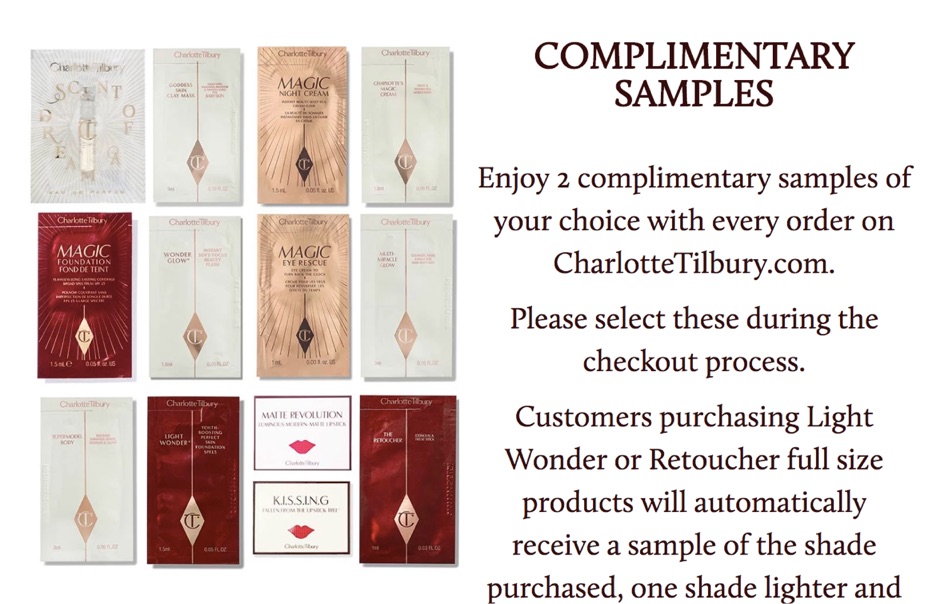
3. Product Launches
Irregular Choice is a fashion brand that sell truly unique shoes, bags and accessories. Over the last year they’ve collaborated with Disney to release some wonderful designs inspired Star Wars, Cinderella, Alice in Wonderland and the Muppets to name a few.

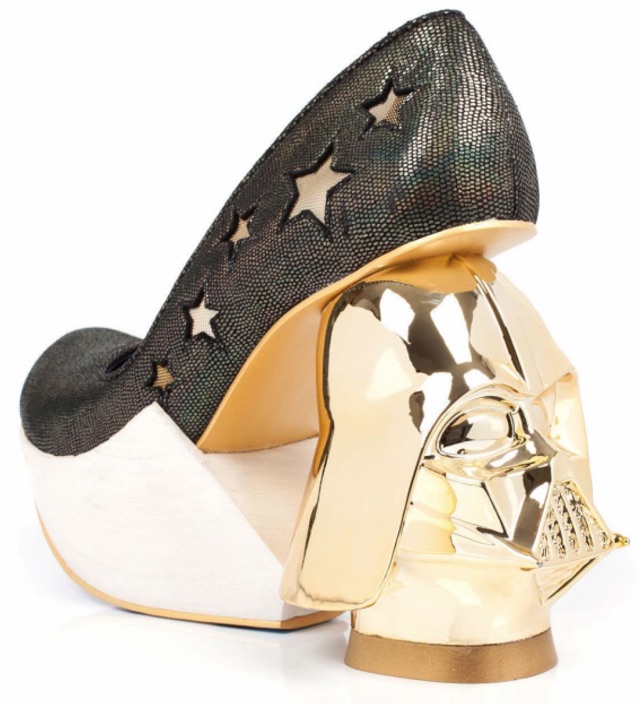
It’s no surprise to find out that customers get very excited about such unique designs. Irregular Choice support this by way of product launches on advertised dates and times and then market these within emails, around the site and on social media. This can be a real success when partnered with in-store shopping events as well.
4. Rewarding Loyalty
Rewarding loyalty doesn’t just have to mean implementing a loyalty points program. Through customer segmentation, we can identify the most loyal customers based on their spending or number of orders and then we can tailor our messaging. If you have product launches or sale periods, you may be able to give them an exclusive or provide them with early access. Even just communicating with them on a more personal level because you are using the context of their previous purchases in the way that you talk to them will make it feel more personal.
5. Thoughtful Packaging
It’s wise not to forget that the shopping experience continues all the way until the arrival of the item and the customer unboxes it.
Smythson are a luxury stationery and leather goods brand with history all the way back to 1887. They invest in this luxury experience by making sure that every order is exquisitely wrapped in tissue paper and carefully presented in a quality gift box finished off with ribbon. This helps to position the product and brand as luxury and, from experience, I can say that it makes the customer feel special as they carefully unwrap it.
Timed and Targeted Re-engagement
Once the on-site and delivery experience has been created, the traditional outreach portion of the customer retention strategy can be tackled. The primary areas to consider are:
- Search Ads
- Remarketing
- Social (ads and engagement)
When approaching designing email campaigns, customer segmentation is a powerful tool to ensure that your messaging is personalised to the customer context increasing its effectiveness. Even abandoned cart emails can be considered one form of customer segmentation.
For those that haven’t really started with customer segmentation, the easiest way to start is to segment based on total spent and number of orders. This will quickly provide a list of VIP customers that can be sent special offers, or early access to news and products like in the case of the product launches mentioned earlier. Once that has been done, the next group down will be “pre-VIP” which are customers that are primed to become brand advocates given some attention.
Another particularly popular form of email campaign over the last year has been a welcome campaign. When customers subscribe to the newsletter, rather than just sending a confirmation email, it’s an opportunity to educate them on the brand and the product highlights. Instead, consider creating a 3-email series that includes information about the brand history and values, provides highlights on the most well-received blog content over the last year and also take the opportunity to continue to educate the customer on the range of your product catalogue and your top selling products.
Other campaigns types to look into include win-back, i.e. when a customer hasn’t purchased for a while, or a customer that has been subscribed for a while and hasn’t placed an order yet.
Customer Segmentation
As I hope it’s starting to become clear, moving away from all communication being broadcast-based is critical for customer engagement. The next level to achieve beyond customer segmentation is by way of personalisation. Recommending different products to each customer, both on the website and in emails, is easily achievable with tools like Nosto. With just a small piece of code, Nosto will track customer behaviour around the site so that it can intelligently suggest products based on their activity and extrapolated needs. This is a particularly smart way of livening up emails, making them more personal than could ever be achieved at this scale manually.
Kissmetrics for eCommerce is a valuable tool as well. Kissmetrics collects person-based behavioral data, defines and tracks key customer segments and then enables you to engage with your customers with more targeted email and facebook campaigns. When you create refined segments of your many different customer types and tailor messaging uniquely toward just that segment you’re creating a memorable experience between your brand and customer which leads to brand loyalty and more repeat purchases.
Outreach
Paid advertising through search, social and remarketing are all incredibly valuable tools in the customer retention strategy chest. Each one will need to be researched, experimented with, evaluated and iterated on to find out what works best.
The point of interest here for returning customers is to have tracking pixels, similar to the Nosto code so that the remarketing networks can target customers based on the categories and products that they’re interested in and, importantly, stop selling to once they’ve ordered.
Strategy Checklist
We’ve covered quite a range of aspects to consider for any customer retention strategy but it’s far from exhaustive list and there are always going to be unique opportunities for each vertical and business.
As a quick summary to use as reference when reviewing your strategy, make sure to consider:
- UX Review & Conversion Rate Optimisation
- User generated content
- Loyalty Programmes
- In-Store Events
- Content Marketing
- Social
- Customer Service
- Delightful shipping
- Customer Segmentation
- Personalised Product Recommendations
- Abandoned Baskets
- Email marketing campaigns
- Advertising
- Remarketing
Remember, that many of these areas will help to improve conversion rates for new customers as well as returning ones!
Finally, as part of any strategy, decide upon some KPIs to track the effectiveness of the strategy. I would expect there to be KPIs for each area implemented as well as overall KPIs. At a high level, these KPIs would include comparing the primary KPIs of number of sessions, orders and therefore conversion rate between new and returning customers. I would also recommend tracking the customer lifetime value and hopefully this will increase which will warrant further investment in acquisition! Then watch the growth cycle continue!
from The Kissmetrics Marketing Blog https://ift.tt/2pRg1LJ
via IFTTT
